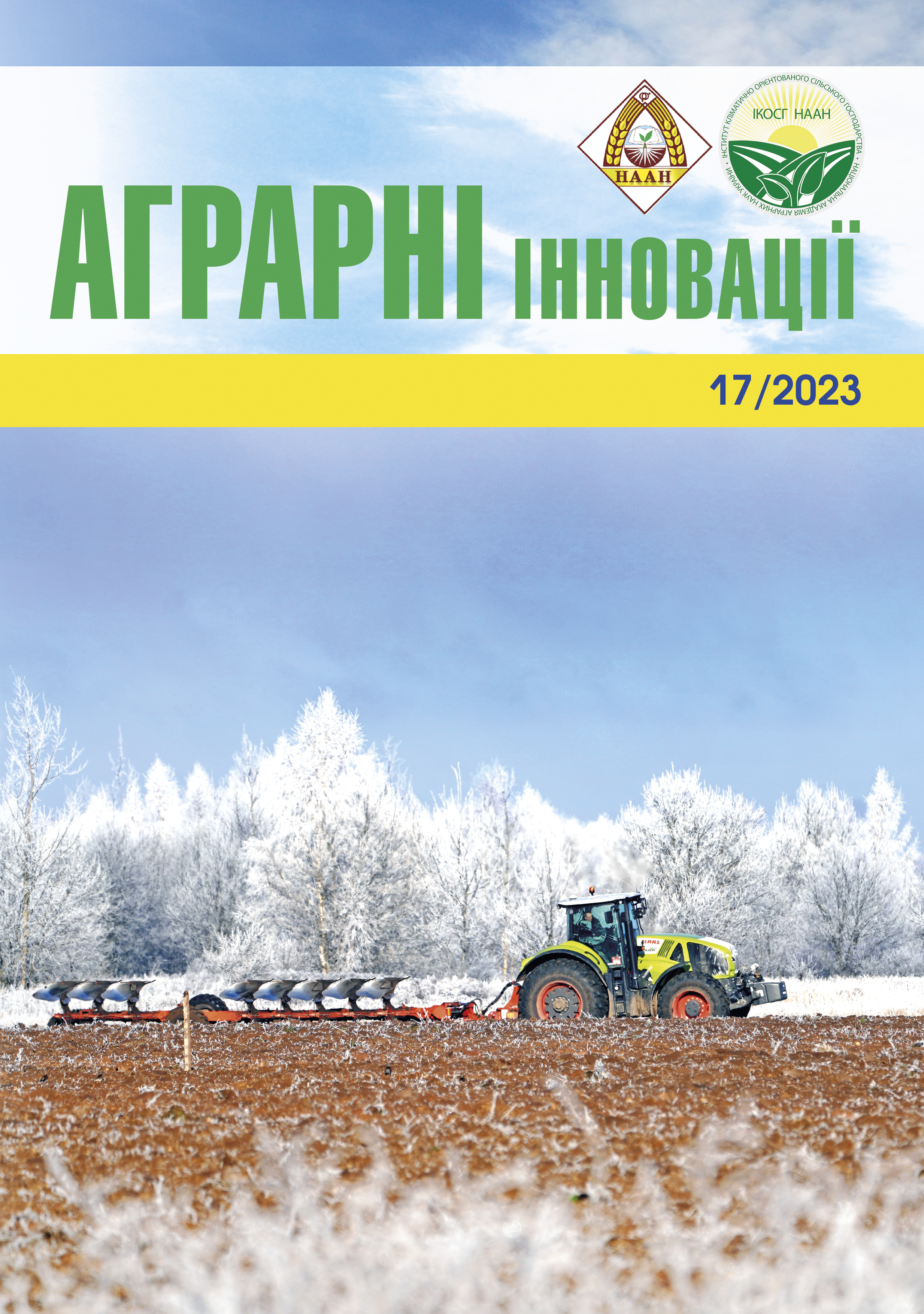THE EFFECTIVENESS OF THE EFFECT OF ADJUSTING SUBSTANCES AND MICROFERTILIZERS ON THE PROCESSES OF FORMING THE PRODUCTIVITY OF SUNFLOWER IN THE CONDITIONS OF THE NORTHERN STEPPE OF UKRAINE
Abstract
The purpose of the work is to identify the effects of drugs that have an impact on the level of productivity of sunflower plants of the Epicurus variety in a zone with unstable moisture (Northern Steppe of Ukraine). Methods. During the growing season of 2021–2022, experimental field research was carried out on the plots in the conditions of the Scientific and Educational Center of Practical Training of the DDAEU and the field of LLC "Dubrava" (Dniprovsky District, Dnipropetrovsk Region). The research methods are general scientific (epmyric), theoretical and systemic. Agrotechnics of sunflower cultivation are generally accepted for the conditions of the Steppe of Ukraine, except for the factors that were studied. The results. The use of plant growth regulators and biopreparations with active substances of various origins on the new promising medium-early high-oil hybrid of the Epicurus sunflower, which increased resistance to adverse external factors, is characterized by a clearly expressed anti-stress effect and an increase in vegetative mass and seed productivity. Processing revealed a significant effect on the leaf surface area (increase by 10.62–12.84% compared to the control), which resulted in an increase in the photosynthetic potential of sunflower seeds. he formation of a larger leaf surface in the flowering vegetation phase was noted when the hybrid was treated with AKM, RK, 0.2 l/t (82.8 thousand m²/ha), Treptol, v.r.s., 20 ml/t (84.9 thousand m²/ha) and Wincrops Antistress, v.r., 1.0 l/ha (85.4 thousand m²/ha). Higher yield indicators (by 0.13; 0.18 and 0.24 t/ha) were formed due to resistance to adverse vegetation conditions and the creation of a cenosis with a higher plant height (by 3.6–9.1 cm) and basket diameter (by 8.46–10.76% relative to the control) on options for processing with the use of a polymer film-forming plant growth regulator AKM, RK (0.2 l/t), a composition of natural growth stimulants and a complex of 2,6 - dimethylpyridine- 1-oxide with succinic acid Treptol, v.r.s. (20 ml/t), complex microfertilizer Wincrops Antistress, v.r. (1.0 l/ha). On the variants with the researched preparations Yaros, v.r.k. (12 l/ha), Kvadrostim, v.r.k. (500 g/t), Leader plus, v.s.r. (0.05 l/ha), AGRINOS A, r. (1.5 l/ha) the effect on sunflower productivity was less pronounced, the increase in seed yield by year ranged from 0.03 to 0.1 t/ha. Conclusions. Impact studies have shown that, in order to grow high sunflower yields, it is necessary to optimize the processes of the formation of vegetative and generative organs, the increase in the above-ground mass of plants and the area of the leaf surface, as well as the photosynthetic activity of crops. It is necessary to take into account the reaction of the Epicurus hybrid when grown in the conditions of the Northern Steppe of Ukraine to the action of growth regulators with anti-stress effect for harvesting the maximum harvest, and it is recommended to use the growth regulator of natural origin Wincrops Antistress, v.r. at a rate of 1.0 l per 1 ha with the aim of a more effective process of mobilizing the capabilities of sunflower in periods of adverse climatic effects.
References
2. Гамаюнова В. В., Кудріна В. С. Формування продуктивності соняшнику під впливом позакореневих підживлень сучасними біопрепаратами в умовах Південного Степу України. Дніпровський державний аграрно-економічний університет. Agrology. Дніпро, 2020. № 4, Т. 3. С. 225‒231.
3. Добровольський А.В., Домарацький Є.О. Особливості реалізації стимулюючої дії комплексних препаратів рослинами соняшника на початкових етапах органогенезу. Аграрний вісник Причорномор’я. 2017. Вип. 84. С. 39–45.
4. Клименко І. І. Вплив регуляторів росту рослин і мікродобрива на урожайність насіння ліній та гібридів соняшнику. Селекція і насінництво. 2015. Вип. 107. С. 183–188.
5. Ткаліч І. Д., Гирка А. Д., Бочевар О. В., Ткаліч Ю. І. Агротехнічні заходи підвищення урожайності насіння соняшника в умовах Степу України. Зернові культури. 2018. Т. 2, № 1. С. 44–52.
6. Фадеев Л. В. Подсолнечник Украины – сегодня и завтра. Харьков : Спец ЭММ, 2014. 129 с.
7. Яровые масличные культуры / В. Щербаков и др.; общ. ред. В. А. Щербакова. Минск : ФУЛинформ, 1999. 288 с.
8. Олійні культури в Україні: навч. посіб. / М. М. Гаврилюк та ін. Київ : Основа, 2008. 420 с.
9. Никитчин Д.И. Подсолнечник: биохимия, селекция, возделывание. Пологи, 2002. 494 с.
10. Пономаренко С. П. Біостимуляція в рослинництві – український прорив. Основи формування продуктивності сільськогосподарських культур за інтенсивних технологій вирощування : зб. наук. праць УДАУ. Умань, 2008. С. 44–51.
11. Шевчук О. А., Кришталь О. О., Шевчук В. В. Екологічна безпека та перспективи застосування синтетичних регуляторів росту рослин. Вісник Вінницького політехнічного інституту. Вінниця, 2014. № 1 (112). С. 34–39.
12. Козлова О. П., Домарацький Є.О., Домарацький О.О. Вплив рістрегулюючих речовин біологічного походження на формування надземної біомаси рослин соняшника. Таврійський науковий вісник. Сільськогосподарські науки. Херсон, 2019. Вип.106. С. 43–52.
13. Лихочвор В.В. Петриченко В.В. Рослинництво. Сучасні інтенсивні технології вирощування основних польових культур. Львів : НВФ Українські технології, 2006. 730 с.
14. Доспехов Б. А. Методика полевого опыта (с основами статистической обработки результатов исследований. Москва: Агропромиздат, 1985. 351 с.
15. Шевченко М.С. Лебідь Є.М. Оптимізація посівних площ соняшнику. Агрономічні закони та економічні пріоритети. Агроном. 2016. № 11. С. 23–26.
16. Грицаєнко З.М. Методи біологічних та агрохімічних досліджень рослин та грунтів / З.М. Грицаєнко, А.О. Грицаєнко, В.П. Карпенко. К.: ЗАТ НІЧЛАВА, 2003. 320 с.






